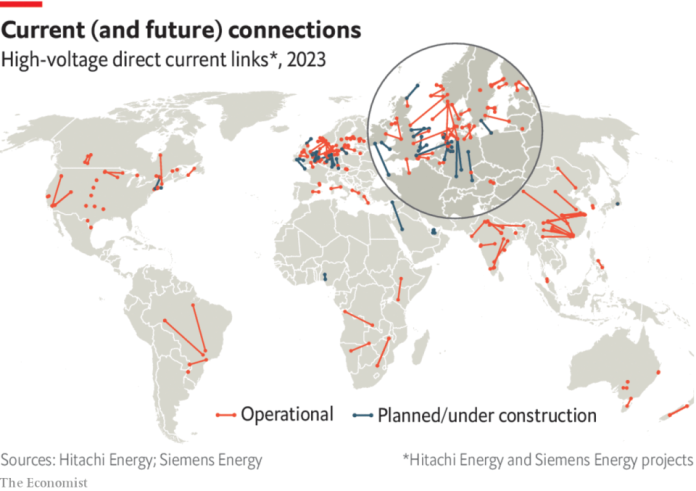When you hear the word “transistor,” you probably think of the tiny on-off switches that sit by the millions on silicon chips. If a name springs to mind, it’s probably William Shockley, the Bell Labs researcher who invented this particular type of semiconductor device in 1947, or Gordon Moore, who was the first to spot the trend towards smaller, cheaper, and better performing once (and who died at the end of March).
However, when a power engineer hears the word, they may think of switches built for muscle power rather than miniaturization and Bantval Jayant Baliga. Born in Chennai in 1948, Mr. Baliga applied the principles of semiconductor physics to the control of currents rather than calculations. In 1980, while working for American conglomerate General Electric, he patented a new breed of semiconductor that was quietly changing the world: the insulated gate bipolar transistor (IGBT).
Like all transistors, IGBTs are electronically controlled on-off switches. They enable fine-grained electronic control for switching high voltages and large currents. This improves the world in many ways. Mr. Baliga is particularly proud of what has been achieved through use in internal combustion engines. He reasonably estimates that their use in ignition systems has made the world’s cars 10% more efficient, and argues that they reduced demand for gasoline by a staggering 42 billion barrels between 1990 and 2020. His calculation ignores the fact that with less efficient cars, people might have driven less far. But it’s hard to begrudge him the oversight, especially since his invention to help the climate isn’t ready yet.
The alternating currents used in networks have many advantages. But they are not good for sending a lot of current over long distances. Long-distance AC power lines require repeater stations along their length to compensate for the losses caused by the magnetic fields generated in the transmission process. Direct current (DC) long-distance lines do not have to compensate for such losses. This property was experimented with by people across Europe in the late 19th and early 20th centuries. The technology was incredibly cumbersome and unreliable, and the other advantages of AC grids meant that they continued to dominate distribution. But DC connectors stayed in some marginal niches and bided their time.
The story goes on
Converting alternating current to direct current was one of many tasks in which the vacuum tubes used in the first half of the 20th century were replaced by semiconductors in the second half. They offered improvements but still had problems – one of which was that the full power of an AC grid was required to bring high-voltage direct current (HVDC) lines into operation. When China built HVDC transmission lines to bring solar and wind power from the north and west to the east coast in the 2010s, it had to build coal-fired power plants alongside it to get them up and running.
The Warp Cores
Technology using IGBTs does not have this problem. It also offers much more flexible switching, making the conversion process much easier, and takes up less space. That turned out to be quite an advantage. Mr. Holt, board member of Siemens Energy, says that 99% of the HVDC systems now sold are based on IGBTs. And its attractions also increase the overall market. HVDC is not just a way to connect distant generators to existing grids, as in China and a number of developing countries with large, remote hydroelectric dams. It can also provide bridges from one part of a network to another, reducing congestion. And it can connect networks that could never be combined into a single AC system.
By semiconductor standards, IGBTs in action are an impressive sight. In the main hall of Blackhillock HVDC converter station in Aberdeenshire, Scotland, they hang from the ceiling, linked to other components in large metal banks that are threaded and wrapped with coolant tubes. When Blackhillock is in operation, no one can enter the hall lest the tremendous voltages flowing through these valves, as they are still called, dictate that living flesh is the quickest route to the ground. Her correspondent was only able to see her thanks to a maintenance break.
If the valves look like a cross between a server cabinet and an oversized engine, the looks are not too deceptive; This is where electricity meets calculation. The valves, which Hitachi Energy makes using IGBTs from a specialist manufacturer, use components called capacitors to store small amounts of electrical charge for short periods of time. The IGBTs control charging and discharging in such a way that the AC input is converted to a continuous DC output. You can also work in reverse, charging and discharging the capacitors in a way that converts incoming DC power to AC power.
Blackhillock is the southern end of an HVDC link that runs under the Moray Firth to Caithness in northern Scotland. The growth of wind farms across Caithness has exceeded the capacity of the local power grid; To keep it stable, some of the farms are shut down on windy days and their owners are reimbursed for the unsold electricity. In 2021, such cut payments in Scotland reached £382m. The Caithness-Moray link delivers this power on a new route south, reducing shutdown and relieving congestion on the grid.
Connecting one point in a synchronous AC grid to another, as the Caithness-Moray link does, is an increasingly popular way to relieve grid congestion without adding new AC capacity (the strengthening of the AC grid across the Hochland would have been much more expensive). Such links not only help the operators; They also help consumers. Before the completion of the Alegro interconnector in 2020, grid bottlenecks often meant that the cheapest electricity from Germany could only get to Belgium via the Netherlands or northern France. Providing a direct connection has lowered prices in both markets. Many such congestion relief systems are under construction in Europe.
Another application of HVDC is to connect independent grids that cannot easily be merged into a larger synchronous system. The North Sea Link, an HVDC cable between Kvilldal on Norway’s west coast and Blyth on England’s east coast, enables the flow of energy between Statnett, the Norwegian grid operator, and the UK National Grid. At 720 km (450 miles), it is currently the longest submarine cable in the world. But it won’t be long. Viking Link, currently under construction between Lincolnshire, further south in England, and Jutland, in Denmark, will soon wear its crown.
The technology will also be used, as in the past, to connect distant renewable energy sources to the grid. Even when the sophistication of IGBTs isn’t required (e.g. in connections where current only ever flows in one direction), their small footprint stands them in good stead. Space is at a premium on offshore platforms. However, sometimes it comes down to their sophistication. “Multiterminal” HVDC, only possible with the flexibility and control offered by IGBT-based conversion, will allow large offshore wind farms to serve more than one grid and act as a link between all the grids they serve .
The northern converter station on the Caithness-Moray link will eventually become a multiterminal. Power will flow in (or out) not only from Blackhillock in the south but also, via a cable under construction, from the Shetland Islands in the north and from new wind farms being built offshore. This means that on any given day, depending on the needs of the grid, energy can be routed from Shetlands to Aberdeenshire, or from offshore wind farms to Shetlands, or a bit of both. Denmark plans to build two giant “wind islands” equipped with HVDC multiterminals. The turbines on both will be connected not only to Denmark but also to its neighbors, allowing power to be sent in both directions. Belgium is building something similar.
Perry Hofbauer, HVDC engineer at sse, calls this grid expansion required by decarbonization the “biggest change in the electricity system in history”. But once you complete this grand expansion challenge, you face the nasty task of leveling them.
© 2023 The Economist Newspaper Limited. All rights reserved.
From The Economist, published under license. For the original content, see https://www.economist.com/technology-quarterly/2023/04/05/electric-grids-fed-by-renewables-need-a-different-kind-of-plumbing
finance.yahoo.com
https://finance.yahoo.com/news/electric-grids-fed-renewables-different-160838593.html















